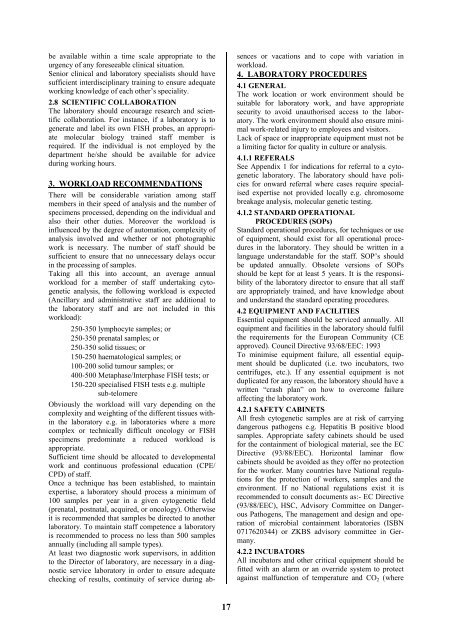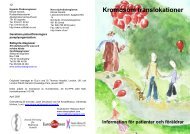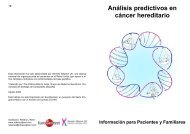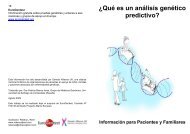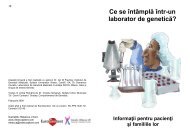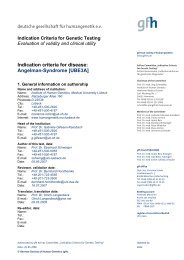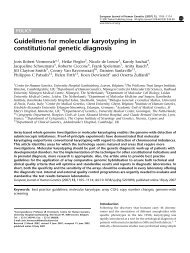Cytogenetic Guidelines and Quality Assurance - EuroGentest
Cytogenetic Guidelines and Quality Assurance - EuroGentest
Cytogenetic Guidelines and Quality Assurance - EuroGentest
Create successful ePaper yourself
Turn your PDF publications into a flip-book with our unique Google optimized e-Paper software.
e available within a time scale appropriate to the<br />
urgency of any foreseeable clinical situation.<br />
Senior clinical <strong>and</strong> laboratory specialists should have<br />
sufficient interdisciplinary training to ensure adequate<br />
working knowledge of each other’s speciality.<br />
2.8 SCIENTIFIC COLLABORATION<br />
The laboratory should encourage research <strong>and</strong> scientific<br />
collaboration. For instance, if a laboratory is to<br />
generate <strong>and</strong> label its own FISH probes, an appropriate<br />
molecular biology trained staff member is<br />
required. If the individual is not employed by the<br />
department he/she should be available for advice<br />
during working hours.<br />
3. WORKLOAD RECOMMENDATIONS<br />
There will be considerable variation among staff<br />
members in their speed of analysis <strong>and</strong> the number of<br />
specimens processed, depending on the individual <strong>and</strong><br />
also their other duties. Moreover the workload is<br />
influenced by the degree of automation, complexity of<br />
analysis involved <strong>and</strong> whether or not photographic<br />
work is necessary. The number of staff should be<br />
sufficient to ensure that no unnecessary delays occur<br />
in the processing of samples.<br />
Taking all this into account, an average annual<br />
workload for a member of staff undertaking cytogenetic<br />
analysis, the following workload is expected<br />
(Ancillary <strong>and</strong> administrative staff are additional to<br />
the laboratory staff <strong>and</strong> are not included in this<br />
workload):<br />
250-350 lymphocyte samples; or<br />
250-350 prenatal samples; or<br />
250-350 solid tissues; or<br />
150-250 haematological samples; or<br />
100-200 solid tumour samples; or<br />
400-500 Metaphase/Interphase FISH tests; or<br />
150-220 specialised FISH tests e.g. multiple<br />
sub-telomere<br />
Obviously the workload will vary depending on the<br />
complexity <strong>and</strong> weighting of the different tissues within<br />
the laboratory e.g. in laboratories where a more<br />
complex or technically difficult oncology or FISH<br />
specimens predominate a reduced workload is<br />
appropriate.<br />
Sufficient time should be allocated to developmental<br />
work <strong>and</strong> continuous professional education (CPE/<br />
CPD) of staff.<br />
Once a technique has been established, to maintain<br />
expertise, a laboratory should process a minimum of<br />
100 samples per year in a given cytogenetic field<br />
(prenatal, postnatal, acquired, or oncology). Otherwise<br />
it is recommended that samples be directed to another<br />
laboratory. To maintain staff competence a laboratory<br />
is recommended to process no less than 500 samples<br />
annually (including all sample types).<br />
At least two diagnostic work supervisors, in addition<br />
to the Director of laboratory, are necessary in a diagnostic<br />
service laboratory in order to ensure adequate<br />
checking of results, continuity of service during ab-<br />
17<br />
sences or vacations <strong>and</strong> to cope with variation in<br />
workload.<br />
4. LABORATORY PROCEDURES<br />
4.1 GENERAL<br />
The work location or work environment should be<br />
suitable for laboratory work, <strong>and</strong> have appropriate<br />
security to avoid unauthorised access to the laboratory.<br />
The work environment should also ensure minimal<br />
work-related injury to employees <strong>and</strong> visitors.<br />
Lack of space or inappropriate equipment must not be<br />
a limiting factor for quality in culture or analysis.<br />
4.1.1 REFERALS<br />
See Appendix 1 for indications for referral to a cytogenetic<br />
laboratory. The laboratory should have policies<br />
for onward referral where cases require specialised<br />
expertise not provided locally e.g. chromosome<br />
breakage analysis, molecular genetic testing.<br />
4.1.2 STANDARD OPERATIONAL<br />
PROCEDURES (SOPs)<br />
St<strong>and</strong>ard operational procedures, for techniques or use<br />
of equipment, should exist for all operational procedures<br />
in the laboratory. They should be written in a<br />
language underst<strong>and</strong>able for the staff. SOP’s should<br />
be updated annually. Obsolete versions of SOPs<br />
should be kept for at least 5 years. It is the responsibility<br />
of the laboratory director to ensure that all staff<br />
are appropriately trained, <strong>and</strong> have knowledge about<br />
<strong>and</strong> underst<strong>and</strong> the st<strong>and</strong>ard operating procedures.<br />
4.2 EQUIPMENT AND FACILITIES<br />
Essential equipment should be serviced annually. All<br />
equipment <strong>and</strong> facilities in the laboratory should fulfil<br />
the requirements for the European Community (CE<br />
approved). Council Directive 93/68/EEC: 1993<br />
To minimise equipment failure, all essential equipment<br />
should be duplicated (i.e. two incubators, two<br />
centrifuges, etc.). If any essential equipment is not<br />
duplicated for any reason, the laboratory should have a<br />
written “crash plan” on how to overcome failure<br />
affecting the laboratory work.<br />
4.2.1 SAFETY CABINETS<br />
All fresh cytogenetic samples are at risk of carrying<br />
dangerous pathogens e.g. Hepatitis B positive blood<br />
samples. Appropriate safety cabinets should be used<br />
for the containment of biological material, see the EC<br />
Directive (93/88/EEC). Horizontal laminar flow<br />
cabinets should be avoided as they offer no protection<br />
for the worker. Many countries have National regulations<br />
for the protection of workers, samples <strong>and</strong> the<br />
environment. If no National regulations exist it is<br />
recommended to consult documents as:- EC Directive<br />
(93/88/EEC), HSC, Advisory Committee on Dangerous<br />
Pathogens, The management <strong>and</strong> design <strong>and</strong> operation<br />
of microbial containment laboratories (ISBN<br />
0717620344) or ZKBS advisory committee in Germany.<br />
4.2.2 INCUBATORS<br />
All incubators <strong>and</strong> other critical equipment should be<br />
fitted with an alarm or an override system to protect<br />
against malfunction of temperature <strong>and</strong> CO2 (where


